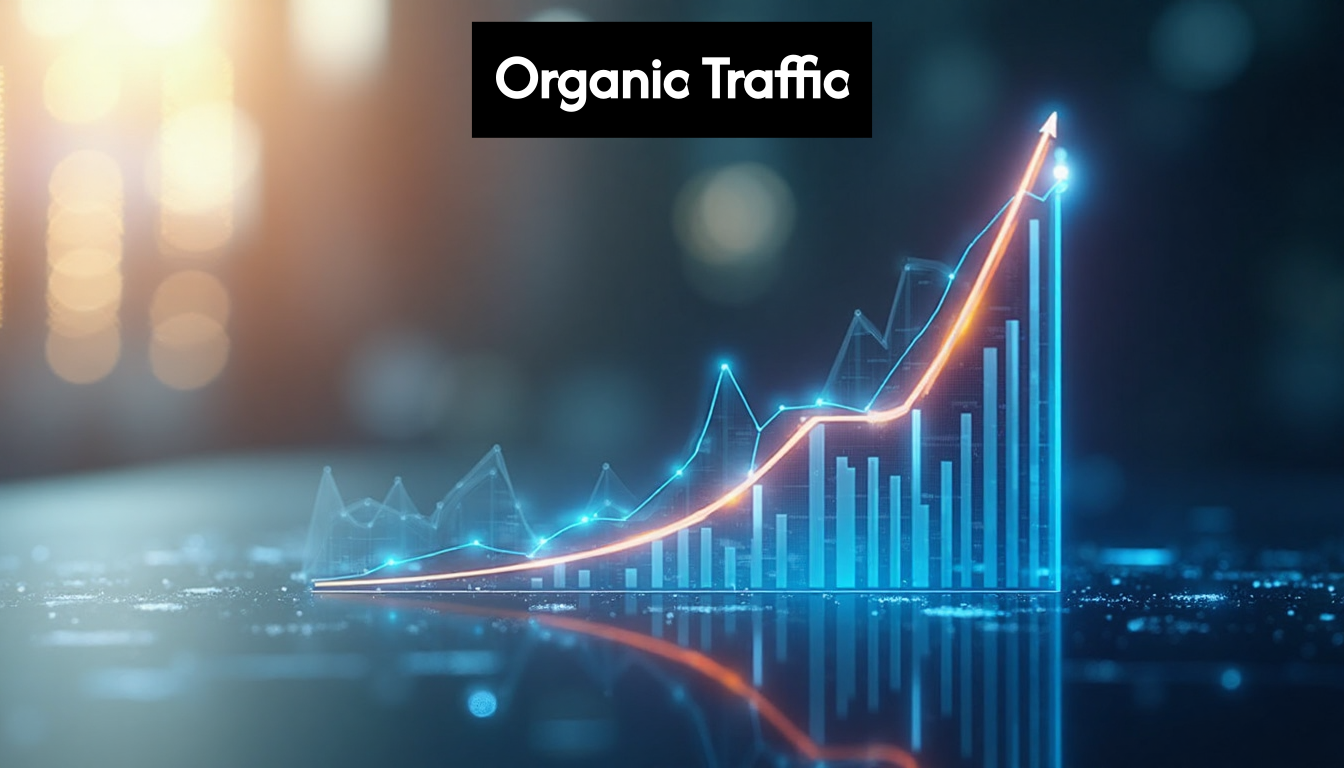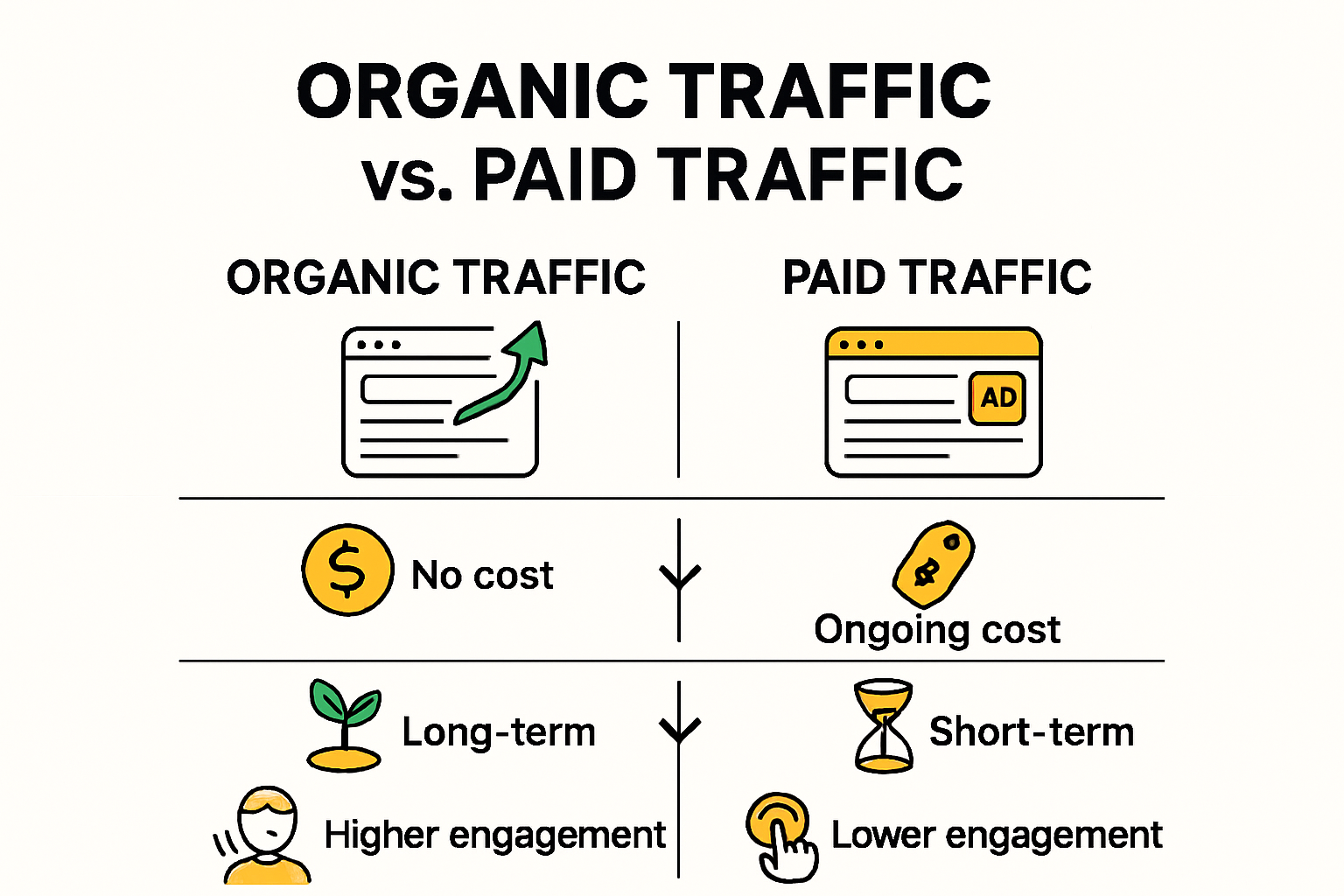Understanding Organic Website Traffic in 2025: A Guide

 Organic website traffic is the lifeblood of digital marketing in 2025. It accounts for an astounding 62% of traffic sources for most companies, highlighting its crucial role in online visibility. But here's the kicker: it's not just about showing up in search results. The vast majority of visitors are actually looking for relevant, high-quality content. This means that if your site doesn't deliver real value, you might be missing out on invaluable engagement and conversions. Dive in to discover how to turn organic traffic into your most powerful ally.
Organic website traffic is the lifeblood of digital marketing in 2025. It accounts for an astounding 62% of traffic sources for most companies, highlighting its crucial role in online visibility. But here's the kicker: it's not just about showing up in search results. The vast majority of visitors are actually looking for relevant, high-quality content. This means that if your site doesn't deliver real value, you might be missing out on invaluable engagement and conversions. Dive in to discover how to turn organic traffic into your most powerful ally.
Table of Contents
- What Is Organic Website Traffic?
- How To Gain Organic Traffic
- Comparing Organic And Paid Traffic
- Measuring Your Organic Success
Quick Summary
| Takeaway | Explanation |
|---|---|
| Organic traffic is sustainable | Unlike paid traffic, organic traffic provides a stable and predictable visitor stream that compounds over time without ongoing financial investment. |
| Content quality is crucial | Developing high-quality, audience-focused content is essential for attracting organic traffic; it addresses user needs and establishes domain authority. |
| Adapt to search behavior changes | Modern strategies must focus on clear, concise answers to user queries, optimizing for features like snippets and voice search to effectively capture organic traffic. |
| Measure beyond traffic numbers | It’s important to track a range of sophisticated metrics, including engagement and conversion contributions, to evaluate organic success accurately. |
| Balance organic and paid strategies | Integrating both traffic types enables businesses to leverage immediate visibility from paid ads while building a robust, sustainable organic presence. |
What is Organic Website Traffic?
Understanding organic traffic is crucial for digital marketers and website owners seeking sustainable online visibility. Organic website traffic represents visitors who arrive at your website through unpaid search engine results, typically by clicking on non-advertisements links that appear in search engine pages like Google, Bing, or Yahoo.
The Fundamental Mechanics of Organic Search
Organic traffic is generated when search engines determine your website's content is relevant and valuable for specific user queries. When users type keywords related to your content, search engines analyze hundreds of factors to rank web pages, including content quality, relevance, website authority, and user experience. Indeed Career Advice confirms that these visitors find your site naturally through search results without any direct advertising spend.
The primary distinction between organic and paid traffic lies in its acquisition method. While paid traffic requires continuous financial investment through advertisements, organic traffic represents a more sustainable and cost-effective approach to attracting website visitors. Content Marketing Institute describes organic search traffic as a "super KPI" of content marketing, highlighting its strategic importance for long-term digital growth.
Why Organic Traffic Matters for Digital Success
Organic traffic offers several compelling advantages for businesses and content creators. Unlike paid traffic that abruptly stops when advertising budgets are exhausted, organic traffic compounds over time, providing a more stable and predictable visitor stream. Backlinko research suggests that significant organic traffic growth typically requires four to six months of consistent, strategic content development.
The value of organic traffic extends beyond mere visitor numbers. These users are often more engaged and have higher conversion potential because they actively seek information related to your content. By focusing on creating high-quality, relevant content that addresses specific user needs, websites can attract targeted organic traffic that is more likely to result in meaningful interactions, whether through purchases, sign-ups, or continued engagement.
Successful organic traffic strategies involve multiple interconnected elements: robust search engine optimization (SEO), compelling content creation, technical website optimization, and a deep understanding of target audience search behaviors. Digital marketers must continuously refine their approach, staying updated with evolving search engine algorithms and user preferences to maintain and improve their organic search performance.
How to Gain Organic Traffic
Gaining organic traffic requires a strategic, multi-faceted approach that combines technical expertise, content quality, and continuous optimization. Digital marketers and website owners must implement comprehensive strategies that align with evolving search engine algorithms and user behaviors.
Content Strategy and Search Engine Optimization
Creating high-quality, audience-focused content remains the cornerstone of organic traffic generation. B Sharp Tech emphasizes that strategic content creation—including blogs, videos, webinars, and in-depth resources—drives sustained organic traffic by directly answering user queries and establishing domain authority. This means developing content that not only includes relevant keywords but provides genuine value to your target audience.
Effective SEO involves more than just keyword insertion. It requires a holistic approach that includes:
- Technical optimization for website speed and mobile responsiveness
- Comprehensive keyword research targeting user intent
- Regular competitor analysis to identify content gaps
- Structured data implementation to enhance search engine understanding
Adapting to Modern Search Behaviors
The landscape of organic traffic is rapidly evolving, particularly with the rise of "zero-click" searches. Ampersand Marketing highlights that modern search strategies must focus on providing immediate value through concise, structured answers. This means developing content that can potentially appear in featured snippets, knowledge panels, and direct answer boxes, even if users do not click through to the full website.
Website owners should prioritize:
- Creating clear, direct answers to common user questions
- Implementing schema markup for enhanced search visibility
- Developing content that addresses specific user intents
- Optimizing for voice search and conversational queries
Long-Term Organic Traffic Development
Successful organic traffic generation is a marathon, not a sprint. It requires consistent effort, continuous learning, and adaptability. Digital marketers must remain committed to producing high-quality content, staying updated with search engine algorithm changes, and continuously refining their approach.
Key long-term strategies include:
- Building high-quality backlinks from reputable websites
- Consistently updating and refreshing existing content
- Developing a diverse content portfolio across multiple formats
- Monitoring analytics to understand user behavior and content performance
By implementing these comprehensive strategies, websites can develop a robust organic traffic approach that not only attracts visitors but keeps them engaged and returning for more valuable content. 
Comparing Organic and Paid Traffic
Understanding the nuanced differences between organic and paid traffic is crucial for developing a comprehensive digital marketing strategy. While both traffic sources aim to drive visitors to a website, they differ significantly in approach, cost, sustainability, and long-term value.

Traffic Distribution and Performance Metrics
First Page Sage research reveals a compelling breakdown of website traffic sources: on average, companies experience 62% organic traffic, 21% paid traffic, 13% from email and social channels, and 4% from other sources. This distribution highlights the fundamental importance of organic search strategies.According to Sagapixel, organic search is projected to dominate website traffic, accounting for 53% of all web traffic by 2025, compared to paid search at 27%. This trend underscores the growing significance of organic traffic generation strategies that focus on providing genuine value and relevance to users.
Cost and Sustainability Considerations
Paid traffic operates on an immediate, transactional model where businesses pay for each click or impression. In contrast, organic traffic represents a long-term investment in content quality, search engine optimization, and user experience. While paid advertising can generate instant visibility, organic traffic offers more sustainable and cost-effective growth.
Key differences include:
- Paid Traffic: Immediate results, direct cost per click, limited duration
- Organic Traffic: Compound growth, no direct per-click expense, sustained visibility
User Engagement and Conversion Dynamics
The E Digital highlights a critical insight: 70% of search clicks are concentrated in the top five organic search results, demonstrating the immense value of organic search positioning. Moreover, 69% of search traffic now originates from long-tail keywords, indicating that users are increasingly seeking specific, nuanced information.Organic traffic tends to generate higher-quality user engagement because these visitors actively seek relevant content. They are more likely to spend time on the website, explore multiple pages, and have a higher potential for conversion compared to paid traffic visitors who might click through more passively.
Digital marketers should view organic and paid traffic as complementary strategies rather than competing approaches. A sophisticated marketing strategy integrates both, leveraging paid traffic for immediate visibility while simultaneously building a robust organic presence that provides long-term, sustainable growth. By understanding the unique strengths of each traffic source, businesses can create a balanced approach that maximizes online visibility and user engagement.
Measuring Your Organic Success
Measuring organic success requires a comprehensive approach that goes beyond simple traffic numbers. Digital marketers must develop a nuanced strategy for tracking performance, understanding user behavior, and demonstrating the tangible value of organic search efforts.
Key Performance Metrics for Organic Traffic
Conductor's 2025 State of Organic Marketing Survey revealed that 91% of respondents confirmed SEO positively impacts website performance and marketing goals. To effectively measure organic success, businesses need to track a range of sophisticated metrics that provide deeper insights into website performance.Critical metrics for measuring organic success include:
- Traffic Volume and Source Breakdown: Understanding where organic visitors originate
- Engagement Metrics: Time on page, scroll depth, and interaction rates
- Conversion Contribution: How organic traffic translates into meaningful business outcomes
- Keyword Performance: Tracking rankings and visibility for target search terms
Advanced Analytics and Tracking Strategies
Plausible Analytics recommends a multi-dimensional approach to measuring organic search performance. This involves not just tracking raw numbers, but understanding the qualitative aspects of user interaction. Digital marketers should focus on metrics that reveal user intent, content effectiveness, and the genuine value provided to website visitors.Key tracking strategies include:
- Implementing comprehensive web analytics tools
- Setting up conversion tracking
- Analyzing user behavior flow
- Monitoring content performance across different audience segments
Long-Term Organic Performance Evaluation
Fire US Marketing highlights that by 2025, organic search will account for 53% of all website traffic, underscoring the importance of robust measurement strategies. Successful organic performance evaluation goes beyond monthly reports, requiring a strategic approach that considers:- Consistent performance tracking
- Comparative analysis against industry benchmarks
- Adaptation of content and SEO strategies based on insights
- Understanding long-term growth trajectories
Effective organic success measurement is not about celebrating individual victories but understanding the continuous improvement of your digital presence. By developing a holistic approach to tracking and analyzing organic performance, businesses can make data-driven decisions that incrementally improve their online visibility and user engagement. The goal is to create a dynamic, responsive strategy that evolves with changing search behaviors and technological advancements.
Frequently Asked Questions
What is organic website traffic?
Organic website traffic refers to visitors who reach your website through unpaid search engine results, clicking on links that are not advertisements. It is generated based on the relevance and value of your website's content for specific user queries.
Why is organic traffic important for businesses in 2025?
Organic traffic is crucial because it provides a sustainable and predictable flow of visitors without ongoing ad costs. It tends to attract highly engaged users, leading to higher conversion rates and meaningful interactions compared to paid traffic.
How can I increase my organic website traffic?
To boost organic traffic, focus on creating high-quality, audience-focused content, implement SEO best practices, adapt to modern search behaviors, and continuously optimize your website to meet user needs and search engine algorithms.
What metrics should I track to measure organic traffic success?
Key performance metrics for evaluating organic traffic success include traffic volume, engagement metrics (time on page, scroll depth), conversion contributions, and keyword performance. These metrics help you understand user behavior and the effectiveness of your content.
Unlock the Full Potential of Your Organic Traffic Today!
Imagine a world where your website not only attracts visitors but keeps them engaged and converts them into loyal customers. With organic traffic accounting for 62% of your visitors, the challenge lies in delivering high-quality, relevant content that stands out against your competition. It’s time to address those pain points—long-term organic growth, superior content quality, and adapting to ever-changing search behaviors!

At BabyLoveGrowth.ai, we specialize in turning these challenges into opportunities. Our automated SEO content generation integrates seamlessly with your business needs, ensuring you stay ahead in the digital landscape. Here’s how we can help:
- In-depth Business Analysis: Understand where you stand and how to improve.
- Customized 30-Day Content Plan: Tailored strategies that resonate with your target audience and optimize for search engines.
- Automatic Generation of SEO-Optimized Articles: Say goodbye to writer’s block and hello to consistent, high-quality content!
Don’t let your competitors steal your spotlight—act now and elevate your online visibility with BabyLoveGrowth.ai! Visit us at https://babylovegrowth.ai and start optimizing your organic traffic today.
Recommended Articles
- Effective SEO Marketing Strategy 2025: Step-by-Step
- How Long Should an Article Be? Proven Strategies for Optimal Content Length
- The Ultimate Guide to Meta Tags: Enhancing Your Website's SEO
- What Is On Page SEO in Digital Marketing: Boost Rankings
- Understanding Content Generation Meaning: Trends for 2025
Smart SEO,
Faster Growth!
Most Read Articles

Generative Engine Optimization (GEO)
Learn how Generative Engine Optimization (GEO) helps your content rank in AI search engines like ChatGPT and Google AI. This comprehensive guide explains the differences between SEO and GEO, why it matters for your business, and practical steps to implement GEO strategies for better visibility in AI-generated responses.

Track LLM Traffic in Google Analytics 4 (GA4)
Learn how to track and analyze traffic from AI sources like ChatGPT, Claude, Perplexity, and Google Gemini in Google Analytics 4. This step-by-step guide shows you how to set up custom filters to monitor AI-driven traffic and make data-driven decisions for your content strategy.

How to Humanize AI Text with Instructions
Learn practical techniques to make AI-generated content sound more natural and human. This guide covers active voice, direct addressing, concise writing, and other proven strategies to transform robotic text into engaging content.

Open AI Revenue and Statistics (2024)
Comprehensive analysis of OpenAI financial performance, user engagement, and market position in 2023. Discover key statistics including $20B valuation, $1B projected revenue, and 100M+ monthly active users.